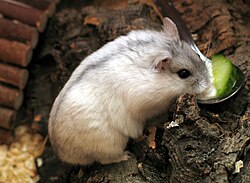Winter white dwarf hamster: Difference between revisions
| Line 68: | Line 68: | ||
*[http://www.xander.it/video.htm Xander.it] - Winter White video gallery |
*[http://www.xander.it/video.htm Xander.it] - Winter White video gallery |
||
*[http://www.furrycritters.co.uk FurryCritters] |
*[http://www.furrycritters.co.uk FurryCritters] |
||
*[http://www.hamster-zone.com/hamster-types/winter-white-hamster |
*[http://www.hamster-zone.com/hamster-types/winter-white-hamster-two-coats-for-the-price-of-one.html Winter White Hamsters] |
||
{{Hamster}} |
{{Hamster}} |
||
Revision as of 21:33, 29 May 2008
This article needs additional citations for verification. (October 2007) |
| Dwarf Winter White Russian Hamster | |
|---|---|

| |
| Scientific classification | |
| Kingdom: | |
| Phylum: | |
| Class: | |
| Order: | |
| Suborder: | |
| Superfamily: | |
| Family: | |
| Subfamily: | |
| Genus: | |
| Species: | P. sungorus
|
| Binomial name | |
| Phodopus sungorus (Pallas, 1773)
| |
| Subspecies | |
|
Phodopus sungorus sungorus (see text) | |
Winter White Russian hamsters are a species of Hamster in the genus Phodopus. They are typically half the size of the better-known Syrian hamster, and therefore called dwarf hamsters along with all Phodopus species. Features include a typically thick dark grey dorsal stripe and furry feet. The tail is so short that it hardly shows when the hamster is sitting. As winter approaches and the days shorten, Winter Whites' dark fur greys until it is almost completely white (hence the name). In the wild, this adaptation helps them evade predators in the snow-covered steppes of winter. They live mainly in Siberia and are also found in Dzungaria, Kazakhstan, Mongolia and Manchuria.
It has been debated whether the Winter White hamster was a sub-species of the Campbell's Dwarf Hamster (Phodopus campbelli) or not; however, recently it was decided that Winter Whites are of their own species, Phodopus sungorus.
The average lifespan of the Winter White Russian Dwarf Hamster is 1½ to 2 years, although they can live longer.
Pet Ownership
Winter Whites are often found on the pet market, in Europe and Asia more so than in North America and indeed are rarely found in pet stores in Canada. Care is similar to that of the Campbell's Dwarf Hamster. Winter White hamsters make good pets for teens or adults, not for younger children. They are likely to bite and do not like to be cuddled or held. Due to a hamsters poor eyesight the risk of falling or jumping off your hand is high. Dwarf Hamsters are pets to watch. Winter White hamsters which could have some Campbells ancestry should not be fed food containing sources of monosaccharides because of the risk of developing diabetes mellitus[1].
-
Pearl Winter White - Front
-
Pearl Winter White - Side
-
Pearl Winter White - Rear
-
Pearl Winter White - Face
-
Pearl Winter White - Face
-
Russian Winter White living in a jar
Breeding
In general, dwarf hamsters typically have more of a family structure than the Syrian Hamster. However, this may be a result of a frequent confusion of the Winter Whites and the Campbell's hamsters. Current research suggests biparental care in Campbell's hamsters (Phodopus campbelli) but not in Winter Whites (Phodopus sungorus).[2] Some report that same-sex pairs and larger groups do not always get along well and frequent fighting may occur and be a great distress for them, or even lead to death.[citation needed]
Phases
There are several phases (colorations) of Winter White hamsters: their normal (dark brownish-grey colouring) or sapphire (blue-grey colouring). A white pattern called pearl (white with coloured hairs) sometimes exists in either phase, producing the normal pearl or sapphire pearl forms. However, these colours may be difficult to find, and the range of colours is much narrower than in the case of the Campbell's.
Winter White hamsters, also called Siberian hamsters, come from the steppes of Siberia and Kazakhstan and possess an adaptation not seen in Campbells: they can moult into a white winter coat. This camouflages them against the snow and also gives them their name. This moulting is brought on by the amount of day light; if the hamster is kept in an environment with short duration of day light (< 13 hours of light/day) for more than 6 weeks, they will change into their winter coat (white guard hair with thick inner hair) with only a single black stripe going through the centre of the back. Such seasonal moulting is mediated through the nocturnal secretion of melatonin, the hormone secreted by the pineal gland. Short day lengths also triggers the regression of the gonads in both male and females, and thus Winter Whites become infertile. Because Winter White hamsters show such photoperiodic and seasonal changes in physiology and various behaviours, it is also used as a research model system for studying seasonality and photoperiodism.
-
Normal colouration.
Campbell's/Winter White Hybrids
Of the five species kept commonly as pets, only the Campbells and Winter Whites are able to interbreed and produce live offspring (hybrids). Hybrids are most often unknowingly produced through incorrect identification of the two similar species of hamsters, and unfortunately the number of hybrids is increasing particularly within pet shops in many countries today where they are often mislabeled as being one or other of the pure species.
Although hybrids make suitable pets, the breeding of hybrids should be avoided as it can cause health and birthing problems, and also the widespread breeding and distribution of hybrids could threaten the existence of both pure species in captivity. Therefore, if intending to breed Russian hamsters it is important to ensure that both hamsters being bred are a pure form of, and of the same, species to avoid producing hybrids.
Footnotes
- ^ Food for your hamster
- ^ Research by Dr. Katherine Wynne-Edwards at Queen's University, Ontario, Canada






